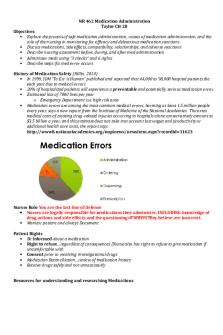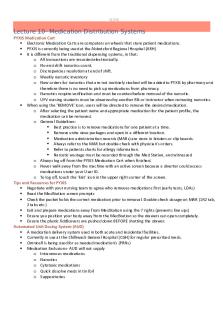7 Rights of Medication Administration & Terminology What are they? PDF

| Title | 7 Rights of Medication Administration & Terminology What are they? |
|---|---|
| Course | Pharmacology |
| Institution | Conestoga College |
| Pages | 5 |
| File Size | 110.7 KB |
| File Type | |
| Total Downloads | 53 |
| Total Views | 143 |
Summary
drug admin...
Description
Pharm 1
Week 10&11
Pharm 1 7 Rights of Medication Administration & Terminology What are they? • Right Patient – identify that you have the right patient. How? • Right Medication – identify medication. Is it this simple? • Right dose – Calculation? Appropriate? Weight-based? • Right Route – For this drug? For this patient? • Right Time – Is it now? Is there an interval? • Right to Know – The patient has a right to know about the medication/drug they are receiving and all side effects there-in • Right to Refuse – The patient, although healthcare personnel may strongly advise against it, may refuse any and all life saving medications, drugs and procedures. 7 Rights – The individual check & balance? • 5 Rights is: • Focused on individual performance • No emphasis on human factors • No emphasis on system elements Limitations • Right Patient – can you always tell? Does it matter? • Right Dose – What if I am by myself? • Right Time – Complex scenes – how do I keep track? • Right Route – Are there any limitations here? • Right Medication – What if I am by myself? Terminology – Ministry required! • ac (Ante Cibos)– before meals • od (Omne In Die)– once daily • bid (Bis In Die)– twice daily • tid (Ter In Die)– three times daily • qid (Quarter In Die)– four times daily • q2h – every 2 hours (“q” means every!) • hs (Hora Somni)– at bedtime (can be confused with half-strength) • pc (Post Cibum)– after meals • prn (pro re nata)– as the situation demands • EC – Enteric-coated i.e. EC-ASA for Enteric-coated ASA • gtt, gtts – drop, drops • MDI – Metered-dose inhaler • N.P.O. – Nothing Per OS – Nothing by mouth
Pharm 1
Week 10&11
Concepts of Undesired or Adverse Effects What is an adverse reaction? • A reaction that may be noxious and is suspected to be as a result of a drug. Predictable vs Unpredictable • Predictable based on the composition and actions of the drug. • Result of the pharmacological effects • Dose dependant • Account for majority of adverse reactions • Sometimes called Type A reactions • • • • •
Unpredictable aka Idiosyncratic Related to immune response Doesn’t appear to be dose dependant Sometimes called Type B May be more severe than Type A
Type A vs Type B Type A • Predictable • Dose dependent • High morbidity, low mortality • Dose reduction will decrease reaction Type B • Unpredictable • Generally not dose dependant • Low morbidity, high mortality • Generally responds when the drug or substance is removed (morbidity refers to your level of health and well-being, mortality is related to your risk of death)
Hypersensitivity • Excessive or inappropriate activation of the immune system Type I – Immediate hypersensitivity • Example – anaphylaxis Type II – Antibody mediated • Drug binding to RBC’s or WBC’s may lead to reactions like transient anemia Type III – Immune complex-Mediated • Serum sickness – presents like allergic reaction i.e. rash/hives, itchiness and occurs from immune system targeting proteins in drugs because if identifies them (falsely) as harmful
Pharm 1
Week 10&11
Type IV – Cell-mediated • Delayed hypersensitivity i.e. Contact dermatitis Teratogenicity and mutagenicity (substances that have an interaction or adverse reaction on the women who is pregnant and will cause birth defects) Teratogenicity • Adverse reactions that are known to cause birth defects in the fetus Mutagenicity • Adverse reactions that result from genetic mutation of the DNA Carcinogenicity • Substances that are known to cause cancer • May have a long latent period i.e. 10 – 20 years after exposure • Carcinogenic substances should be avoided Drug Dependency & Addiction - When someone requires a drug/substance to function normally on a day-to-day basis, they are said to be dependent. • Examples include – alcohol dependency etc. - Not to be confused with addiction – more compulsive and lacks self-control regardless of the consequences. - People can be both dependent and addicted! - Withdrawal symptoms – does it always mean addiction? Legal Implications for Paramedics Intro • Paramedics sometimes work in austere environments • But! • Medication administration may provide positive effects – i.e. pain control • We don’t have the luxury of this hence, increased risk for error! Negligence – Duty to Act • Duty to act • Under the law paramedics have a duty to help someone • On versus off shift? You are on your way in for a night shift when you come across an accident scene. What is your duty to act in this situation? Negligence – Breach of duty • Breach of duty to act • Failing to provide the level/standard of care – what would the reasonable or prudent person do under the circumstances? • Is this why we have medical directives?
Pharm 1
Week 10&11
You are nearing the end of your shift a call comes in for chest pain. You arrive and find that the patient qualifies for Nitroglycerin but because it includes more documentation, you decide not to give the medication.
Negligence – Causation • Causation • Were the actions of the paramedic a large factor in in bringing about harm? A patient with chest pain calls for assistance. First responders arrive , assess the patient to be vital signs absent. They apply their AED and the patient experiences a return of spontaneous circulation. ACP’s arrive, assess the patient, administers a medication that is the improper dose and the patient experiences a seizure. It is later found that the patient suffered brain damage. • Did the OD of the medication cause the seizure and subsequent brain damage or was that the result of the cardiac arrest? Negligence – Harm • Harm • Must be harm to the patient for trial of negligence You respond to an MVC to find an ambulatory patient with no apparent injuries who is refusing treatment and transport. You note minor damage to the vehicle. A proper refusal is completed and the patient is released. He returns home and the next morning wakes with a throbbing headache for which he seeks medical attention at the local ED. He is diagnosed with a cerebral aneurysm that requires surgery and develops some lasting paralysis as a result. Was harm committed? If so, were there acts or omissions from paramedics that resulted in harm to the patient? Good Samaritan Act, 2001 • “Health care professional” – member of a College as per Regulated Health Professions Act • Implications for paramedics! • “Despite the rules of common law, a person described in subsection (2) who voluntarily and without reasonable expectation of compensation or reward provides the services described in that subsection is not liable for damages that result from the person’s negligence in acting or failing to act while providing the services, unless it is established that the damages were caused by the gross negligence of the person.” Negligence – Avoidance • Know your scope of practice • Medication administration and BLS/ALS standards • Act in good faith • ---Treat everyone like they are your family • Omissions or commissions
Pharm 1
Week 10&11 •
---Do the job to the best of your ability. If it will cause harm, don’t do it! Is it that simple?
Negligence Prevention • Be well educated • Be well rested – good luck! • Know medical directives • Lifelong learning Other legal considerations • Storage and security – are drugs stored in such a way to prevent error? • Drug currency – is the drug expired? Did you check? • Environmental Issues – proper storage temperature • This is more a service specific consideration • Documentation – accuracy, adequate detail?...
Similar Free PDFs

Medication Administration
- 3 Pages

Medication Administration
- 6 Pages

Chapter 31 Medication Administration
- 18 Pages

Chapter 31 Medication Administration
- 27 Pages

Test 1 Medication Administration
- 9 Pages

Chapter 35 Medication Administration
- 16 Pages
Popular Institutions
- Tinajero National High School - Annex
- Politeknik Caltex Riau
- Yokohama City University
- SGT University
- University of Al-Qadisiyah
- Divine Word College of Vigan
- Techniek College Rotterdam
- Universidade de Santiago
- Universiti Teknologi MARA Cawangan Johor Kampus Pasir Gudang
- Poltekkes Kemenkes Yogyakarta
- Baguio City National High School
- Colegio san marcos
- preparatoria uno
- Centro de Bachillerato Tecnológico Industrial y de Servicios No. 107
- Dalian Maritime University
- Quang Trung Secondary School
- Colegio Tecnológico en Informática
- Corporación Regional de Educación Superior
- Grupo CEDVA
- Dar Al Uloom University
- Centro de Estudios Preuniversitarios de la Universidad Nacional de Ingeniería
- 上智大学
- Aakash International School, Nuna Majara
- San Felipe Neri Catholic School
- Kang Chiao International School - New Taipei City
- Misamis Occidental National High School
- Institución Educativa Escuela Normal Juan Ladrilleros
- Kolehiyo ng Pantukan
- Batanes State College
- Instituto Continental
- Sekolah Menengah Kejuruan Kesehatan Kaltara (Tarakan)
- Colegio de La Inmaculada Concepcion - Cebu









